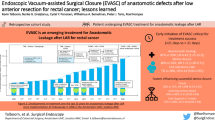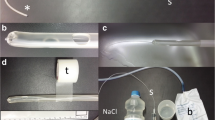Abstract
Objective
Anastomotic leakage after rectal resection is associated with high morbidity and mortality. Patients without peritonitis can be treated conservatively by transrectal rinsing and drainage. However, healing is often very slow, and formation of abundant scar tissue resulting in a poor functional result is not uncommon. Vacuum-assisted closure (VAC) has been shown to accelerate wound healing by increasing local blood flow, reducing bacterial load and stimulating growth of granulation tissue. In this paper, we describe VAC as a method for treating anastomotic leakage after rectal resection.
Methods
Four patients with anastomotic leakage after rectal resections were treated with VAC.
Results
Healing time for these patients was median 51 days (43–195). The control group consisted of patients treated conservatively in the previous 5-year period. Ten patients were identified with median healing time 336 days (52–1434).
Conclusion
VAC treatment may possibly shorten healing time of anastomotic leakages after rectal resection. However, the presented results are preliminary, with only few patients included, and obviously, larger, randomized, clinical trials are needed to confirm these results and establish the indication for VAC treatment in clinical practice. We believe VAC therapy is a promising treatment of anastomotic leakage after rectal resection.


Similar content being viewed by others
References
Rullier E et al (1998) Risk factors for anastomotic leakage after resection of rectal cancer. Br J Surg 85:355–358
Averbach AM, Chang D, Koslowe P, Sugarbaker PH (1996) Anastomotic leak after double-stapled low colorectal resection. Dis Colon Rectum 39:780–787
Keighley MRB, Williams NS (eds) (1993) Surgery of the anus, rectum and colon. Saunders, Philadelphia, pp 1024–1026
Argenta LC, Morykwas MJ (1997) Vacuum-assisted closure: a new method for wound control and treatment: clinical experience. Ann Plast Surg 38:563–576
Morykwas MJ, Argenta LC, Shelton-Brown EI, McGuirt W (1997) Vacuum-assisted closure: a new method for wound control and treatment: animal studies and basic foundation. Ann Plast Surg 38:553–562
Schaffzin DM, Douglas JM, Stahl TJ, Smith LE (2004) Vacuum-assisted closure of complex perineal wounds. Dis Colon Rectum 47:1745–1748
Fleck TM et al (2002) The vacuum-assisted closure system for the treatment of deep sternal wound infections after cardiac surgery. Ann Thorac Surg 74:1596–1600
Eginton MT, Brown KR, Seabrook GR, Towne JB, Cambria RA (2003) A prospective randomized evaluation of negative-pressure wound dressings for diabetic foot wounds. Ann Vasc Surg 17:645–649
Argenta PA, Rahaman J, Gretz HF III, Nezhat F, Cohen CJ (2002) Vacuum-assisted closure in the treatment of complex gynecologic wound failures. Obstet Gynecol 99:497–501
Cro C, George KJ, Donnelly J, Irwin ST, Gardiner KR (2002) Vacuum assisted closure system in the management of enterocutaneous fistulae. Postgrad Med J 78:364–365
Wiedenhagen R, Spelsberg F, Lang RA, Jach KW, Gruetzner KUA (2003) New method for sepsis control caused by anastomotic leakage in rectal surgery—the endo-VAC. Colorectal Dis 5(Suppl 2):1–4
Author information
Authors and Affiliations
Corresponding author
Rights and permissions
About this article
Cite this article
Nagell, C.F., Holte, K. Treatment of anastomotic leakage after rectal resection with transrectal vacuum-assisted drainage (VAC). Int J Colorectal Dis 21, 657–660 (2006). https://doi.org/10.1007/s00384-005-0083-4
Accepted:
Published:
Issue Date:
DOI: https://doi.org/10.1007/s00384-005-0083-4




